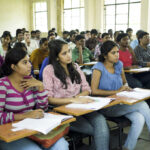
Join top-rated SSC CGL coaching to get esteemed central job
Central Government job attracts youths nowadays to a wider extent. If you are one of those seeking to get a central job to hold an esteemed position, you need to appear and pass SSC Combined Graduate Level (CGL) exam. Meanwhile, for preparation, you need to join a reputed SSC CGL coaching center that promises to offer the best guidance and ensure your success.
We are a top-rated SSC CGL coaching center possessing a wonderful track record. Many of our students successfully passed the SSC CGL exam and hold prestigious profiles. Founded by a group of experts who has the sole aim to help aspirants in getting a government job, Himalai Classes is aware of question patterns, exam rules, regulations, etc. We also keep eye on the latest changes in SSL CGL exam patterns and help aspirants in preparing accordingly.
Our experienced teachers take care of every preparation needs of every student and provide them expert guidance to make their preparation accordingly. We charge a reasonable fee with the aim to make it affordable for everyone. We endeavor to help maximum people in fulfilling their dream of becoming a government employee.
About SSC (Staff Selection Commission) 2021-22
Staff Selection Commission (SSC) established in 1975. SSC is an examination conducted to recruit staff to various posts in ministries, departments, and organizations of the Government of India.
Combined Graduate Level Examination (CGL)
- The Staff Selection Commission (SSC) conducts the Combined Graduate Level (CGL) Exam for the recruitment of Grade “B” and “C” category posts in various Government Ministries, Departments, and Offices.
- Besides, the SSC CGL exam is held in 4 stages called Tiers. Tier-I and Tier-II, Tier-III and Tier-IV
- Besides, Tier-I and Tier-II are online exams, whereas Tier-III and Tier-IV are offline exams.
- The entire process of registration and communication happens online through the official website of SSC CGL.
- Candidates must qualify each stage of the SSC CGL exam to proceed to the next one, before being finally selected.
- SSC CGL is considered to be one of the biggest examinations to be conducted for graduate students in India.
- SSC conducts SSC CGL every year to recruit staff for various posts in the various Ministries and Departments of the Government of India and in its Subordinate Offices.
- SSC CGL 2020 will be a great opportunity for students looking forward to a position in the reputed organizations under the central government.
Recruitment Process
SSC CGL 2020 Examination will be conducted in four tiers as indicated below:
Scheme of the Examination:
The Examination will be conducted in four tiers as indicated below:
- Tier-I: Computer Based Examination
- Tier-II: Computer Based Examination
- Tier-III: Pen and Paper Mode (Descriptive paper)
- Tier-IV: Computer Proficiency Test/ Data Entry Skill Test (wherever applicable).
Eligibility Criteria
Age Relaxation for SSC CGL
Education qualification
SSC CGL Eligibility Criteria as per Nationality mandates a candidate to be a resident of the prescribed states only. Candidates belonging to these states will be eligible to apply for SSC CGL. An applicant must fulfill any one of the following conditions:
- The aspirants must be an Indian Citizen
- The candidates be a subject of Nepal/Bhutan
- The aspirants are Tibetan refugees who moved to India, before 1962, with the intention of settling down permanently in India.
- The applicant must be a Person of Indian Origin who has moved to India from Burma, Pakistan, Uganda, Kenya, Sri Lanka, Tanzania, Malawi, Zambia, Ethiopia, Zaire, and Vietnam with the intention of settling down permanently in India.
2021-22 Educational Qualification
Candidates complete their Graduation from any renowned Institution/University.
More specifically, the Bachelor’s degree in any program is eligible to appear for the entrance test.
Note – Apart from this, the candidates should study either in Mathematics/ Statistics/ Economics as an elective subject or as a compulsory subject.
Other academic qualifications corresponding to the different posts are given below.
Essential Educational Qualifications
For the post of Assistant Audit Officer/ Assistant Accounts Officer:
Primary Qualifications: Bachelor’s Degree from a recognized University or Institute.
Desirable Qualifications: Chartered Accountant or Cost & Management Accountant or Company Secretary or Masters in Commerce or Masters in Business Studies or Masters in Business Administration (Finance) or Masters in Business Economics. During the period of probation direct recruits shall have to qualify the “Subordinate Audit/ Accounts Service Examination” in respective branches for confirmation and regular appointment as Assistant Audit Officer/Assistant Accounts Officer.
Junior Statistical Officer:
Primary Qualification Bachelor’s Degree in any subject from a recognized University or Institute with at least 60% Marks in Mathematics at 12th standard level;
Or
Essential Qualification – Bachelor’s Degree in any subject with Statistics as one of the subjects at degree level.
All other Posts:
Primary Qualification Bachelor’s Degree from a recognized University or equivalent. The candidates appearing in the final year of their graduation can also apply,
However they must possess Essential qualification on or before 01-01-2021.
For the post of Compiler
Basic Qualification: Bachelor’s Degree from any recognized University or Institution. Additionally, candidates must have studied either Economics or Statistics or Mathematics as a compulsory or elective subject.
For the post of Assistant Section Officer (CSS)
Basic Qualification: Bachelor’s Degree from a recognized University or Institute
Additional Qualification: In addition to the basic Undergraduate Degree, candidates must also qualify in the Computer Proficiency Test.
Fitness Requirements
SSC CGL Eligibility 2021: Physical Fitness Requirements
To appear the SSC CGL Exam, the aspirants require to have the specified physical standards before the final round of selection.
Physical Standards for the Inspector (Central Excise/ Examiner/Preventive officer)
The physical fitness requirement includes weight, height, and eye-sight. Read the following content to know more about the SSC CGL Physical Standard Requirements:
- Inspector (Central Excise)- CBIC (Central Board of Indirect Taxes and Customs)
- Inspector (Preventive Officer)-CBIC (Central Board of Indirect Taxes and Customs)
- Sub-Inspector-CBI (Central Bureau of Investigation)
- Inspector-CBN (Central Bureau of Narcotics)
- Inspector (Examiner)-CBIC (Central Board of Indirect Taxes and Customs)
- Upper Divisional Clerk-BRO (Border Road Organisation)
- Sub-Inspector-NIA (National Investigation Agency)
- Sub-Inspector-CBN (Central Bureau of Narcotics)
Exam Pattern
SSC CGL exam will be conducted in 4 Stages as follows
The Examination will be conducted in four tiers as indicated below:
- Tier-I: Computer Based Examination
- Tier-II: Computer Based Examination
- Tier-III: Pen and Paper Mode (Descriptive paper)
- Tier-IV: Computer Proficiency Test/ Data Entry Skill Test (wherever applicable).
Stage 1 : SSC CGL Stage 1 Exam pattern
Tier I-Computer Based Examination
Stage 2 : SSC CGL Stage 1I Exam pattern
Tier II-Computer Based Examination
Stage 3 : SSC CGL Stage III Exam pattern
Tier III- Written Examination
Stage 2 : SSC CGL Stage 1I Exam pattern
Tier IV- Written Examination
All candidates who have applied successfully for SSC CGL 2020 exam, will be assigned Roll numbers and Admit Card for appearing in the Computer Based Examination (Tier-I).
- Based on the marks scored in Tier-I, candidates will be shortlisted, category-wise, to appear in Tier-II and Tier-III Examinations.
- Tier-II and Tier-III Examinations will be conducted for all the candidates qualified in Tier-I. Candidates Qualified in Tier-III will be eligible for Tier-IV Exams.
Syllabus
- Paper 1 – General Intelligence & Reasoning:
- Verbal Analogies, space visualization, similarities and differences, spatial orientation.
- Problem-solving, observation, analysis, decision making, visual memory, judgment, discrimination, relationship concepts.
- Arithmetical reasoning & figural classification, arithmetic number series.
- Non Verbal coding & decoding, statement conclusion, syllogistic reasoning.
- Semantic Analogy, Symbolic/ Number Analogy, Figural Analogy, Semantic Classification, Symbolic/ Number Classification, Figural Series, Semantic Series, Trends, Number Series, Figural Classification, Word Building, Problem Solving, Numerical Operations, symbolic Operations, Coding and de-coding, Space Orientation, Space Visualization, Punched hole/ pattern- folding & un-folding, Drawing inferences, Venn Diagrams, Figural Pattern- folding and completion, Indexing.
- Address matching, Classification of center codes/roll numbers, Date & city matching, Small & Capital letters/ numbers coding, Embedded Figures, Critical thinking, Social
- Paper 1I – General Awareness:
- History, Culture, Economic Scene, Geography, General Policy & Scientific Research.
- Paper III – Quantitative Aptitude:
- Computation of whole numbers, fractions and relationships between numbers, decimals, Percentage.
- Ratio & Proportion, Time & Work, Profit and Loss, Interest, Averages, Square roots, Time and distance, Partnership Business, Basic algebraic identities of School Algebra & Elementary surds, Graphs of Linear Equations, Mixture and Alligation, Congruence and similarity of triangles, tangents, Triangle and its various kinds of centers, angles subtended by chords of a circle, Circle, and its chords, Triangle, Regular Polygons, Quadrilaterals, Common tangents to two or more circles, Circle, Right Circular Cone, Right Prism, Right Circular Cylinder, Sphere, Hemispheres, Regular Right Pyramid with triangular or square base, Rectangular Parallelepiped, Standard Identities, Degree and Radian Measures, Trigonometric ratio, Heights and Distances, Complementary angles, Frequency polygon, Histogram, Bar diagram & Pie chart.
- Paper IV – English Comprehension:
- English, basic comprehension and writing ability.
Tier-II Syllabus
- Paper 1 – Quantitative Abilities:
- Computation of whole numbers and Percentage
- Fractions & relationships between numbers
- Square roots, decimals, Interest, Averages, Discount, Partnership Business.
- Mixture and Alligation, Frequency polygon, Time and Distance, Profit & Loss, Basic algebraic identities of School Algebra & Elementary surds, Graphs of Linear Equations, Time & Work, tangents, Triangle and its various kinds of centers, angles subtended by chords of a circle, common tangents to two or more circles, Circle, Quadrilaterals, Triangle, Right Circular Cone, Sphere, Regular Polygons, Right Prism, Rectangular Parallelepiped, Right Circular Cylinder, Regular Right Pyramid with triangular or square base, Degree and Radian Measures, Hemispheres, Standard Identities, Histogram, Complementary angles, Trigonometric ratio, Heights and Distances, Congruence and similarity of triangles, Pie chart and Bar diagram.
- Paper II – English Language and Comprehension:
- Spotting the error
- Fill in the blanks
- Synonyms
- Antonyms
- Spelling/detecting miss-spelled words
- Idioms & phrases
- One word substitution
- Improvement of sentences
- Active/passive voice of verbs
- Conversion into Direct/Indirect narration
- Shuffling of sentence parts
- Shuffling of sentences in a passage
- Close passage
- Comprehension passage
- Paper III – Statistics:
- Collection, Classification & Presentation of Statistical Data – Primary & Secondary data, Tabulation of data, Frequency distributions, Methods of data collection, Diagrammatic presentation of frequency distributions.
- Measures of Central Tendency- Common measures of central tendency – mean median and mode, deciles, Partition values- quartiles.
- Measures of Dispersion- Common measures dispersion – range, percentiles, quartile deviations, mean deviation and standard deviation, Measures of relative dispersion.
- Moments, Skewness & Kurtosis – Different types of moments & their relationship
- Meaning of skewness & kurtosis, different measures of skewness & kurtosis.
- Correlation & Regression – Scatter diagram, simple correlation coefficient, simple regression lines, Measures of association of attributes, Spearman‟s rank correlation
- Multiple regression.
- Multiple and partial correlations (For three variables only).
- Probability Theory – Meaning of probability, Compound probability Different definitions of probability, Independent events, Conditional probability, Bayes‟ theorem.
- Random Variable and Probability Distributions – Random variable
- Expectation and Variance of a random variable
- Probability functions
- Exponential distributions, Joint distribution of two random variables (discrete) and Higher moments of a random variable, Binomial, Poisson, Normal.
- Sampling Theory – Concept of population and sample, Parameter and statistic, Probability and nonprobability sampling techniques(simple random sampling, multiphase sampling, cluster sampling, Sampling distribution(statement only), stratified sampling, multistage sampling, purposive sampling, systematic sampling, convenience sampling, and quota sampling), Sample size decisions.
- Statistical Inference – Testing of hypothesis, Methods of estimation (Moments method, Least squares method, Maximum likelihood method), Point estimation and interval estimation, properties of a good estimator, Basic concept of testing.
- Small sample and large sample tests, Chi-square and F statistic, Confidence intervals, Tests based on Z t.
- Analysis of Variance – Two-way classified data and Analysis of one-way classified data.
- Time Series Analysis -Determinations of trend component by different methods, Components of time series, Measurement of seasonal variation by different methods.
- Index Numbers – Meaning of Index Numbers, Problems in the construction of index numbers, Types of index numbers, Different formulae, Cost of living Index Numbers, Base shifting and splicing of index numbers, Uses of Index Numbers.
- Paper IV – General Studies-Finance and Economics:
Part A: Finance and Accounts
- Fundamental principles and basic concept of Accounting:
Financial Accounting:
- Nature and scope
- Limitations of Financial Accounting
- Basic concepts and Conventions
- Generally Accepted Accounting Principles
- Basic concepts of accounting:
- Single and double entry
- Books of Original Entry
- Bank Reconciliation
- Journal
- Ledgers
- Rectification of Errors
- Trial Balance
- Manufacturing
- Profit & Loss Appropriation Accounts
- Trading
- Balance Sheet Distinction between Capital and Revenue Expenditure
- Valuation of Inventories,
- Non-profit organisations Accounts,
- Depreciation Accounting
- Bills of Exchange
- Receipts and Payments and Income & Expenditure Accounts,
- Self-Balancing Ledgers.
Part B: Economics and Governance
- Comptroller & Auditor General of India
- Constitutional provisions,
- Role and responsibility.
- Finance Commission-Role and functions.
- Introduction and Basic Concept of Economics to Micro Economics:
- Definition,
- Methods of economic study, Production possibilities curve and Central problems of an economy.
- Theory of Demand and Supply
- Meaning and determinants of demand,
- Law of demand and Elasticity of demand,
- Price, income & cross elasticity,
- Theory of consumer’s behavior Marshallian approach, Meaning & determinants of supply and Indifference curve approach.
- Law of supply & Elasticity of Supply.
- Theory of Production & cost:
- Meaning & Factors of production,
- Laws of production-Laws of returns to scale and Law of variable proportions.
- Price determination in different markets and Forms of Market:
- Various forms of markets-Perfect Competition,
- Monopoly
- Monopolistic Competition & Oligopoly ad Price determination in these markets.
- Indian Economy:
- Indian Economy Role of different sectors.
- Role of Agriculture
- Industry & Services-their problems and growth.
- National Income of India-Concepts of national income
- Different methods of measuring national income.
- Population-Its size,
- rate of growth & its implication on economic growth.
Poverty and unemployment- Absolute & relative poverty, types, causes & incidence of unemployment.
- Infrastructure-
- Economic Reforms in India: Economic reforms since 1991, Liberalisation, Privatisation, Globalisation & Disinvestment.
- Money & Banking:
- Monetary/ Fiscal policy- Role & functions of Reserve Bank of India, functions of commercial Banks/RRB/Payment Banks.
- Budget & Fiscal deficits & Balance of payments.
- Fiscal Responsibility & Budget Management Act, 2003.
- Role of Information Technology in Governance.
Tier III- Written Examination
- Descriptive Paper English or Hindi
Tier IV Skill Test
- Computer Proficiency Test (CPT)
- Word Processing
- Spread Sheet
- Generation of Slides
Why Himalai
Himalai's IAS provides result-oriented coaching to civil services students. The Study Center has been using 100% Examination Oriented Study Materials prepared by experienced faculties, with weekly test series. Besides, Himalai has guided thousands of students in shaping their dreams by producing record-breaking results since 1998. Himalai IAS Coaching Centre in Bangalore is a pioneer in all UPSC civil service examinations. Exam Classes are conducted in all 12 centers of Himalai.




